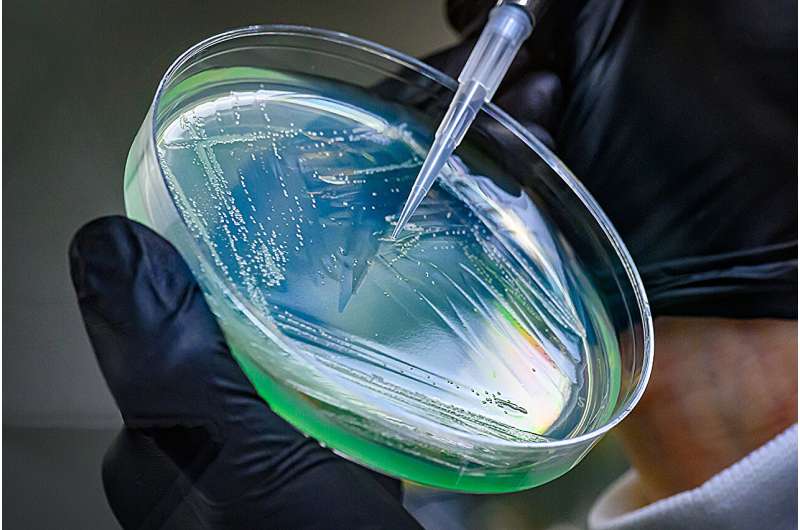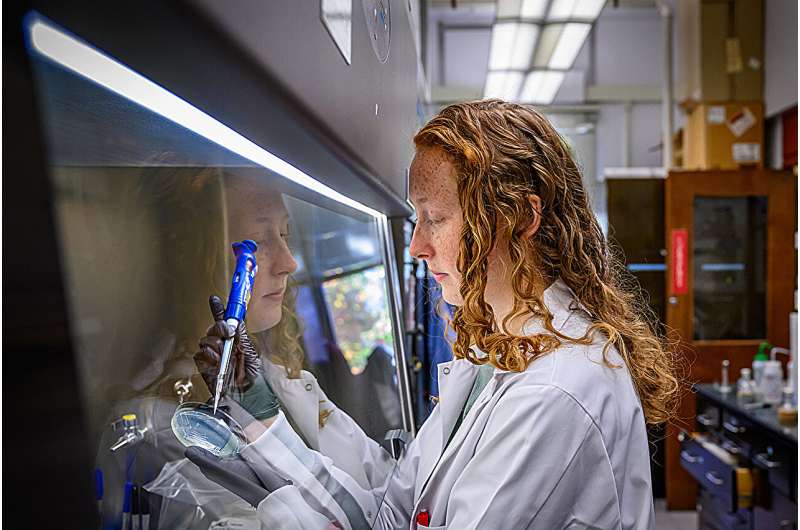This article has been reviewed according to Science X's editorial process and policies. Editors have highlighted the following attributes while ensuring the content's credibility:
fact-checked
peer-reviewed publication
trusted source
proofread
Team discovers rules for breaking into Pseudomonas

Researchers report in the journal Nature that they have found a way to get antibacterial drugs through the nearly impenetrable outer membrane of Pseudomonas aeruginosa, a bacterium that—once it infects a person—is notoriously difficult to treat.
By bombarding P. aeruginosa with hundreds of compounds and using machine learning to determine the physical and chemical traits of those molecules that accumulated inside it, the team discovered how to penetrate the bacterium's defenses. They used this information to convert an antibacterial drug that previously had no activity against P. aeruginosa into one that did.
"Pseudomonas is still the most difficult to treat gram-negative infection, and gram-negative infections are very challenging to treat in general," said University of Illinois Urbana-Champaign chemistry professor Paul Hergenrother, who led the work with Emily Geddes, a handful of other graduate students and postdoctoral researchers in the Hergenrother lab and collaborators at Roche. "The Food and Drug Administration has not approved a new class of antibiotic drugs against gram-negatives in over 50 years."
Gram-negative bacteria differ from gram-positive in the composition of their cell walls. P. aeruginosa has a tightly packed outer membrane that's negatively charged, Geddes said. "This makes it really hard for other molecules to get through by passive diffusion."
P. aeruginosa also has other defenses, including highly specialized porins that allow it to bring in specific nutrients while keeping out everything else and efflux pumps that eject unwanted compounds, Geddes said.
Pseudomonas has 12 efflux pumps, Geddes said. "That really gives it a diversity of drug-resistance mechanisms that some other bacterial species just don't have."
"Our goal here was to basically test a bunch of compounds to see what types of molecules get in the bacterial cell and stay in the cell, and hopefully learn some design principles from that," she said.
Earlier studies of P. aeruginosa focused primarily on antibiotics, testing which ones could kill or weaken the bacterium, Hergenrother said.
"We took a different approach—testing a variety of nonantibiotic compounds and tracking which ones accumulated inside. We then used machine learning to make sense of the chemical traits that were common to the accumulators," he said.
This approach revealed that, among other traits, compounds with a positive charge on the surface and those with more hydrogen-bond-donor surface area were more likely to accumulate inside P. aeruginosa.
Such compounds "can create sort of a gap in the bacterial membrane and destabilize it to let other things come through," Geddes said.

Once they knew what characteristics a compound must have to penetrate Pseudomonas, the researchers chose to test those rules by modifying an existing antibiotic drug, fusidic acid, that is used to treat gram-positive infections but has no activity against gram-negative bacteria. The researchers modified the drug to create a derivative form, called FA prodrug, that included the features identified in the machine-learning exercise.
The experiment worked, Geddes said.
"As we increased the positive charge and as we increased the hydrogen-bond-donor surface area, we saw a corresponding increase in accumulation of the FA prodrug in Pseudomonas," she said. "We saw a 64-fold improvement in activity with those changes."
"Fusidic acid alone has no activity whatsoever against Pseudomonas," Hergenrother said. "And so being able to build that in is a pretty powerful demonstration of the rules."
The FA prodrug itself probably will not be pursued as a candidate drug to fight Pseudomonas infections, Geddes said. However, the principles learned in the study will aid the design of new compounds to fight these dangerous, drug-resistant infections.
Hergenrother is also a professor at the Carle Illinois College of Medicine and the Carl R. Woese Institute for Genomic Biology and deputy director of the Cancer Center at Illinois.
More information: Paul Hergenrother, Porin-independent accumulation in Pseudomonas enables antibiotic discovery, Nature (2023). DOI: 10.1038/s41586-023-06760-8. www.nature.com/articles/s41586-023-06760-8
Journal information: Nature
Provided by University of Illinois at Urbana-Champaign




















